Reverse Time Migration Imaging Using SH Shear Wave Data
Abstract
Featured Application
Abstract
1. Introduction
2. Application Background and Method Principles
2.1. Survey Background
2.2. Principle of Reverse Time Migration
- (1)
- The source wave field is obtained by using the source constructed manually or extracted from actual data, and the corresponding model is numerically simulated to obtain the source wave field , where is the space vector.
- (2)
- Using the seismic data obtained at the receiver, the reverse continuation propagation passes through the same velocity model, and the corresponding receiver wave field is obtained, where the position of the receiver is .
- (3)
- We can then apply appropriate imaging conditions, such as cross-correlation, we obtain the (reverse-time migration image results):where is the source wavefield obtained by forward modeling, is the receiver wavefield obtained by reverse continuation simulation at the same time under the same velocity model, and t is the total propagation time.
2.3. Depth Domain Velocity Model Building for SH Shear Wave Data
2.4. Principle of Combined Compact Difference Scheme
3. Analysis of Combined Compact Difference Scheme
4. Real Data Application
4.1. Data Characteristics
4.2. Depth Domain Imaging Matching and Velocity Model Building
4.3. RTM Results of P and SH Shear Wave
5. Conclusions
Author Contributions
Funding
Institutional Review Board Statement
Informed Consent Statement
Data Availability Statement
Conflicts of Interest
References
- Gou, L.; Zhang, S.; Li, X. Improving the Effectiveness of Shear-wave Seismic Exploration through Geophysical Technology Innovation. Pet. Sci. Technol. Forum 2021, 40, 12–19. [Google Scholar]
- Shao, Z.; He, S.; Hou, L.; Wang, Y.; Tian, C.; Liu, X.; Zhou, Y.; Hao, M.; Lin, C. Dynamic Accumulation of the Quaternary Shale Biogas in Sanhu Area of the Qaidam Basin, China. Energies 2022, 15, 4593. [Google Scholar] [CrossRef]
- Bouchaala, F.; Guennou, C. Estimation of viscoelastic attenuation of real seismic data by use of ray tracing software: Application to the detection of gas hydrates and free gas. Comptes Rendus Geosci. 2012, 344, 57–66. [Google Scholar] [CrossRef]
- Matsushima, J.; Ali, M.Y.; Bouchaala, F. A novel method for separating intrinsic and scattering attenuation for zero-offset vertical seismic profiling data. Geophys. J. Int. 2017, 211, 1655–1668. [Google Scholar] [CrossRef]
- Li, X.; Zhang, S. Forty years of shear-wave splitting in seismic exploration: An overview. Geophys. Prospect. Pet. 2021, 60, 190–209. [Google Scholar]
- Gaiser, J.E. 3-D converted shear wave rotation with layer stripping. U.S. Patent US5610875, 11 March 1997. [Google Scholar]
- Wu, Y.; He, Z.; He, J.; Deng, Z.; Wang, Y.; Yin, W. P-wave and S-wave joint acquisition technology and its application in Sanhu Area. In SEG Technical Program Expanded Abstracts 2018; Society of Exploration Geophysicists: Tulsa, OK, USA, 2018; pp. 1–5. [Google Scholar]
- Takougang, E.M.T.; Ali, M.Y.; Bouzidi, Y.; Bouchaala, F.; Sultan, A.A.; Mohamed, A.I. Characterization of a carbonate reservoir using elastic full-waveform inversion of vertical seismic profile data. Geophys. Prospect. 2020, 68, 1944–1957. [Google Scholar] [CrossRef]
- Dai, F.; Zhang, F.; Li, X.-Y. SH-SH wave inversion for S-wave velocity and density. Geophysics 2022, 87, A25–A32. [Google Scholar] [CrossRef]
- Zhang, F. Simultaneous inversion for S-wave velocity and density from the SV-SV wave. Geophysics 2021, 86, R187–R195. [Google Scholar] [CrossRef]
- LI, X.Y. Processing P-P and P-S waves in multicomponent sea-floor data for azimuthal anisotropy: Theoryandoverview. Oil Gas Sci. Technol. 1998, 53, 607–620. [Google Scholar]
- Zhang, F.; Li, X. Inversion of the reflected SV-wave for density and S-wave velocity structures. Geophys. J. Int. 2020, 221, 1635–1639. [Google Scholar] [CrossRef]
- Cheng, J.W.; Zhang, F.; Li, X.Y. Nonlinear amplitude inversion using a hybrid quantum genetic algorithm and the exact zoeppritz equation. Pet. Sci. 2022, v, 1048–1064. [Google Scholar] [CrossRef]
- Cheng, J.W.; Zhang, F.; Li, X.Y. Seismic Amplitude Inversion for Orthorhombic Media Based on a Modified Reflection Coefficient Approximation. Surv. Geophys. 2022, v, 1–39. [Google Scholar] [CrossRef]
- Deng, Z.; Li, C.; Chen, G.; Yang, J.; Wang, R.; Hu, Y.; An, S.; Wang, H.; Du, Z. The application of pure shear wave seismic data for gas reservoir delineation. In SEG Technical Program Expanded Abstracts 2019; Society of Exploration Geophysicists: Tulsa, OK, USA, 2019; pp. 2690–2694. [Google Scholar]
- Brian, R.; Larry, L. A Gassmann consistent rock physics template. CSEG Rec. 2013, 38, 22–30. [Google Scholar]
- Li, X.Y. Fractured reservoir delineation using multicomponent seismic data. Geophys. Prospect. 1997, 45, 39–64. [Google Scholar] [CrossRef]
- Chang, W.; McMechan, G.A. 3-D elastic prestack, reverse-time depth migration. Geophysics 1994, 59, 597–609. [Google Scholar] [CrossRef]
- Du, Q.Z.; Zhu, Y.T.; Ba, J. Polarity reversal correction for elastic reverse time migration. Geophysics 2012, 77, S31–S41. [Google Scholar] [CrossRef]
- Dai, N.; Wu, W.; Zhang, W.; Wu, X. TTI RTM using variable grid in depth. Int. Pet. Technol. Conf. 2011, v, 1–7. [Google Scholar]
- Zhang, J.; Tian, Z.; Wang, C. P- and S-wave separated elastic wave equation numerical modeling using 2D staggered-grid. In Proceedings of the 77th Annual International Meeting, SEG, San Antonio, TX, USA, 14 September 2007; pp. 2104–2109. [Google Scholar]
- Xiao, X.; Leaney, W.S. Local vertical seismic profiling (VSP) elastic reverse-time migration and migration resolution: Salt-flank imaging with transmitted P-to-S waves. Geophysics 2010, 75, S35–S49. [Google Scholar] [CrossRef]
- Gu, B.; Li, Z.; Ma, X.; Liang, G. Multi-component elastic reverse time migration based on the P and S separating elastic velocity-stress equation. J. Appl. Geophys. 2015, 112C, 62–78. [Google Scholar] [CrossRef]
- Wang, W.; McMechan, G.A.; Zhang, Q. Comparison of two algorithms for isotropic elastic P and S decomposition in the vector domain. Geophysics 2015, 80, T147–T160. [Google Scholar] [CrossRef]
- Du, Q.; Gong, X.; Zhang, M.; Zhu, Y.; Fang, G. 3D PS-wave imaging with elastic reverse-time migration. Geophysics 2014, 79, S173–S184. [Google Scholar] [CrossRef]
- Zhang, Q.; McMechan, G.A. 2D and 3D elastic wavefield vector decomposition in the wavenumber domain for VTI media. Geophysics 2010, 75, D13–D26. [Google Scholar] [CrossRef]
- Du, Q.Z.; Guo, C.F.; Zhao, Q.; Gong, X.; Wang, C.; Li, X.Y. Vector-based elastic reverse time migration based on scalar imaging condition. Geophysics 2017, 82, S111–S127. [Google Scholar] [CrossRef]
- Nguyen, B.D.; McMechan, G.A. Five ways to avoid storing source wavefield snapshots in 2D elastic prestack reverse time migration. Geophysics 2015, 80, S1–S18. [Google Scholar] [CrossRef]
- Tian, J.; Zeng, X.; Wang, W.; Shaosheng, Z.; Zeqing, G.; Hua, K. The detection of biogas in unconsolidated sandstone formation of the Qua-ternary in Qaidam Basin. Geophys. Prospect. Pet. 2016, 55, 408–413. [Google Scholar]
- Sun, P.; Guo, Z.-Q.; Zhang, L.; Tian, J.-X.; Zhang, S.-S.; Zeng, X.; Kong, H.; Yang, J. Biologic gas accumulation mechanism and exploration strategy in Sanhu area, Qaidam Basin. Nat. Gas Geosci. 2013, 24, 494–504. [Google Scholar]
- Chen, G.; Deng, Z.; Jiang, T.; Junyong, Z.; Xuejiao, Y.; Chengye, Q.; Xiaoping, X. Application of PP-wave and SS-wave joint interpretation technology in gas cloud area. Lithol. Reserv. 2019, 31, 79–87. [Google Scholar]
- Zhu, T.; Harris, J.M.; Biondi, B. Q-compensated reverse-time migration. Geophysics 2014, 79, S77–S87. [Google Scholar] [CrossRef]
- Helene, H.V.; Martin, L. Simultaneous inversion of PP and PS seismic data. Geophysics 2006, 71, R1–R10. [Google Scholar]
- Ruixue, S.; Ayse, K.; Christopher, J. High resolution seismic reflection PP and PS imaging of the bedrock surface below glacial deposits in Marsta, Sweden. J. Appl. Geophys. 2022, 198, 1–13. [Google Scholar]
- Chu, P.C.; Fan, C.W. A three-point combined compact difference scheme. J. Comput. Phys. 1998, 140, 370–399. [Google Scholar] [CrossRef]
- Dong, L.; Zhan, J. Combined super compact finite difference scheme and application to simulation of shallow water equations. Chin. J. Comput. Mech. 2008, 25, 791–796. [Google Scholar]
- Sengupta, T.K.; Ganeriwal, G.; De, S. Analysis of central and upwind compact schemes. J. Comput. Phys. 2003, 192, 677–694. [Google Scholar] [CrossRef]
- Wu, G.C.; Wang, H.Z. Analysis of numerical dispersion in wave 2 field simulation. Prog. Geophys. 2005, 20, 58–65. [Google Scholar]
- Zhou, C.; Wu, W.; Sun, P.; Yin, W.; Li, X. The Combined Compact Difference Scheme Applied to Shear-Wave Reverse-Time Migration. Appl. Sci. 2022, 12, 7047. [Google Scholar] [CrossRef]
- Brian, R.; Hedlinz, K.; Hilterman, F.J.; Lines, R. Tutorial Fluid-property discrimination with AVO: A Biot-Gassmann perspective. Geophysics 2003, 68, 29–39. [Google Scholar]
- Jin, S. Tying PS to PP depth section: Two examples of anisotropic prestack depth imaging of 4C data. In SEG Technical Program Expanded Abstracts 2002; Society of Exploration Geophysicists: Tulsa, OK, USA, 2002. [Google Scholar]
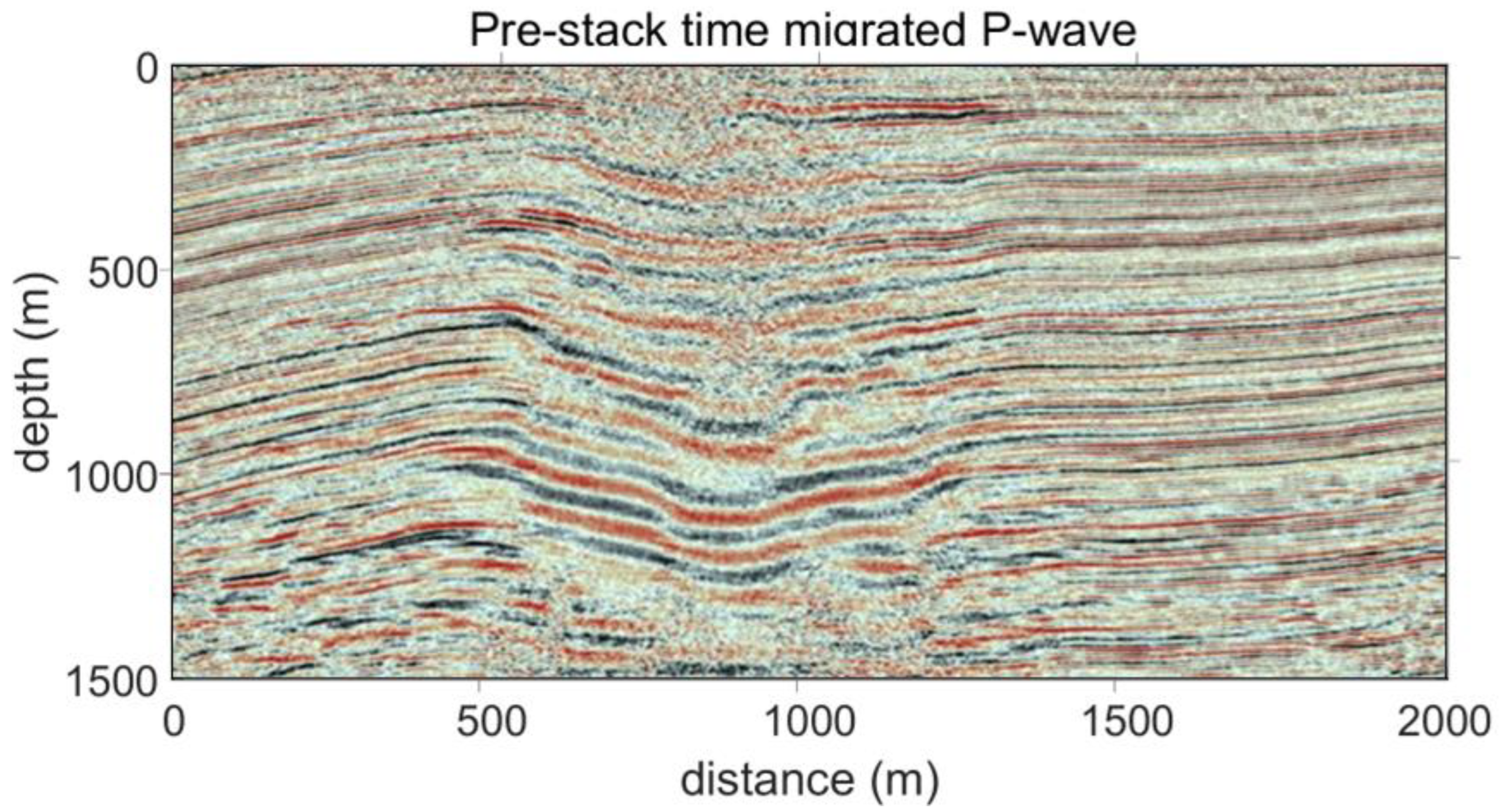



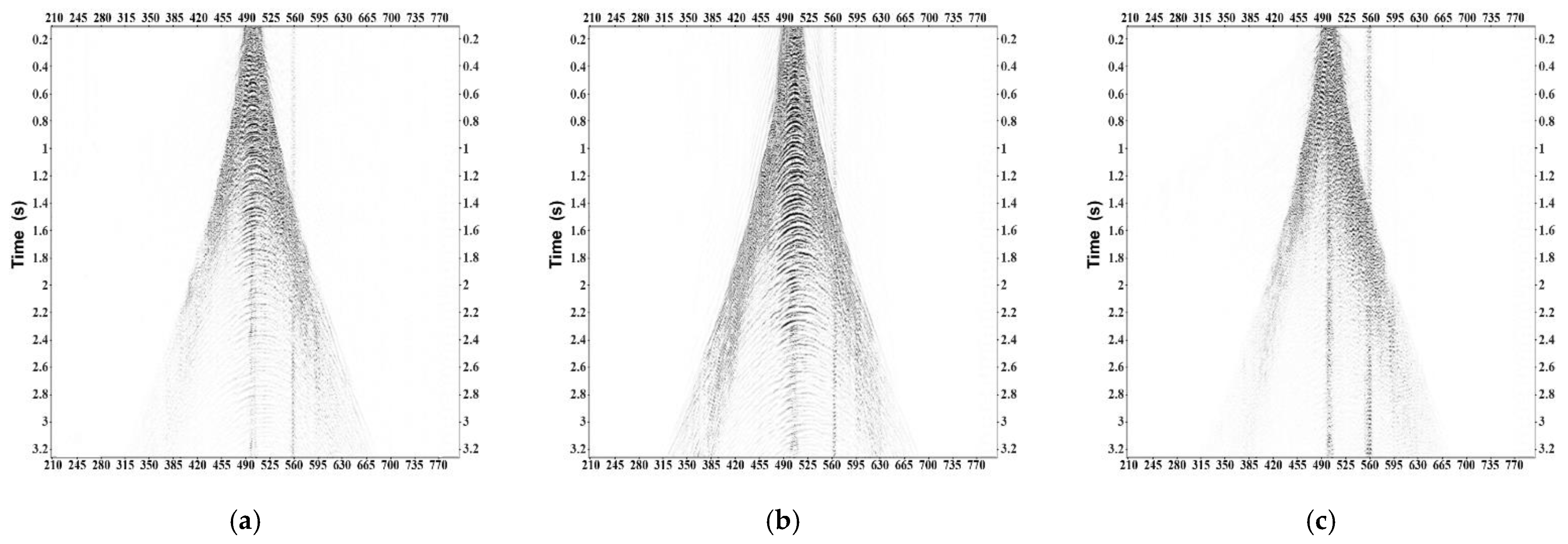
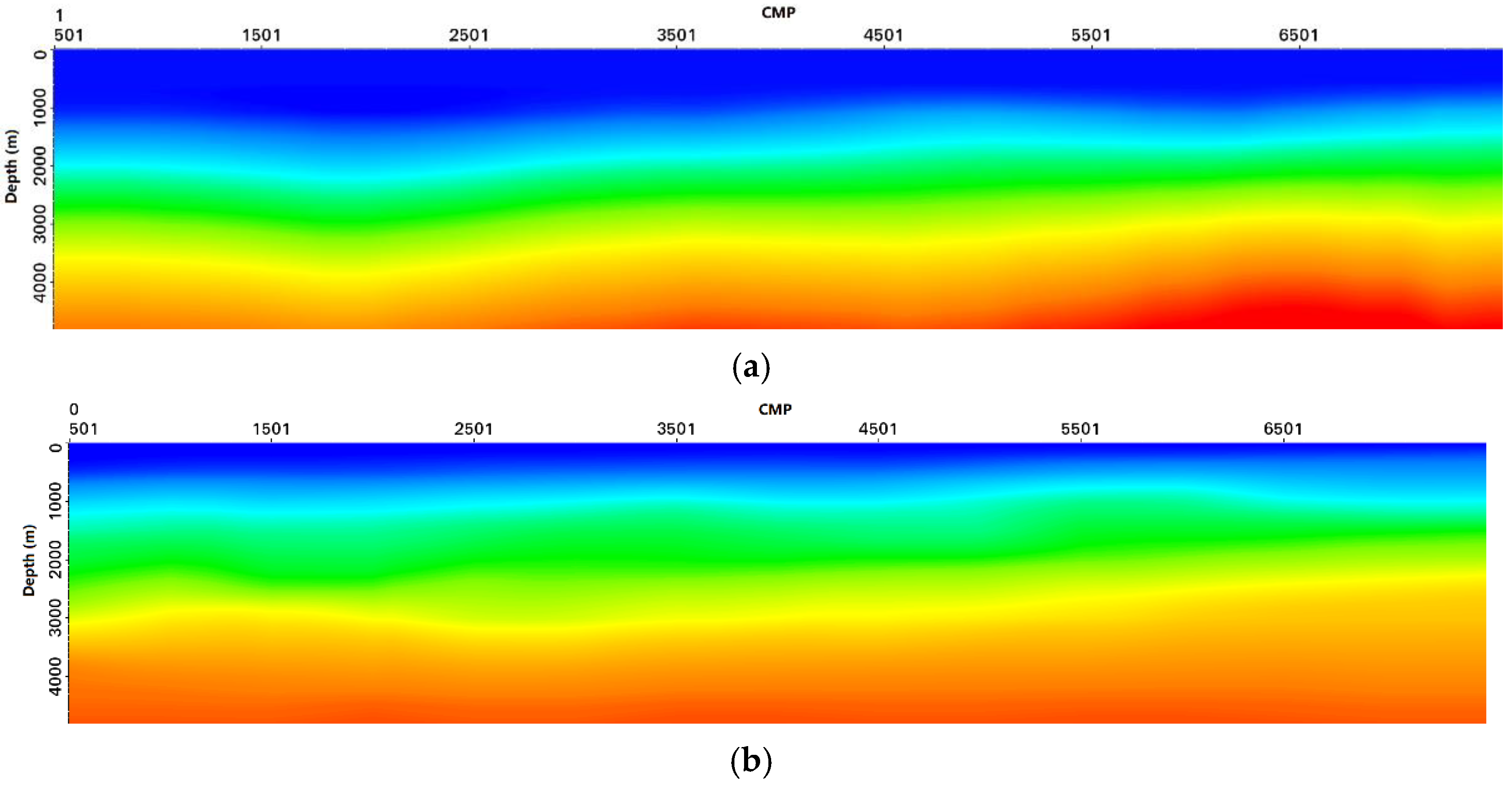

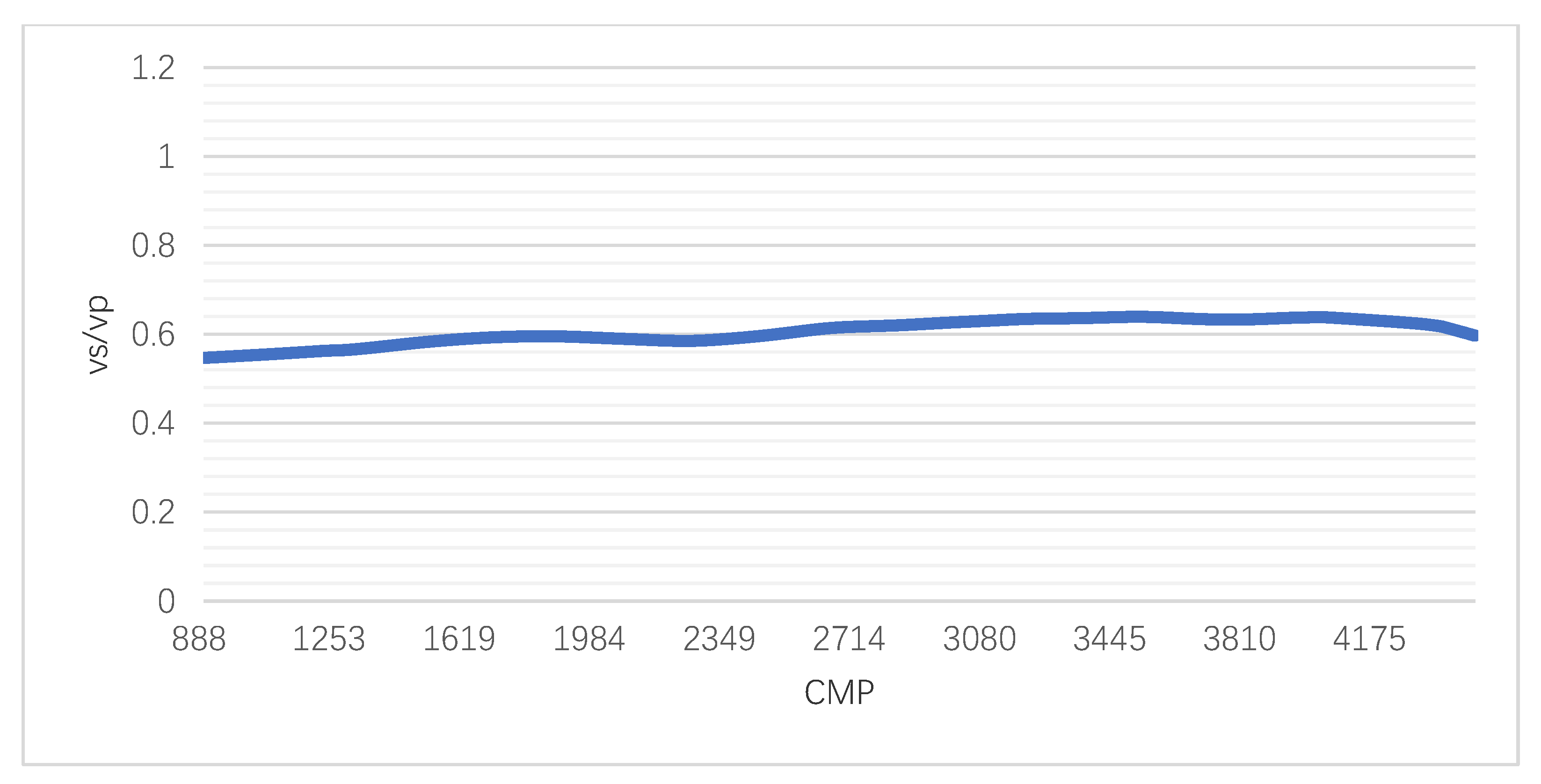
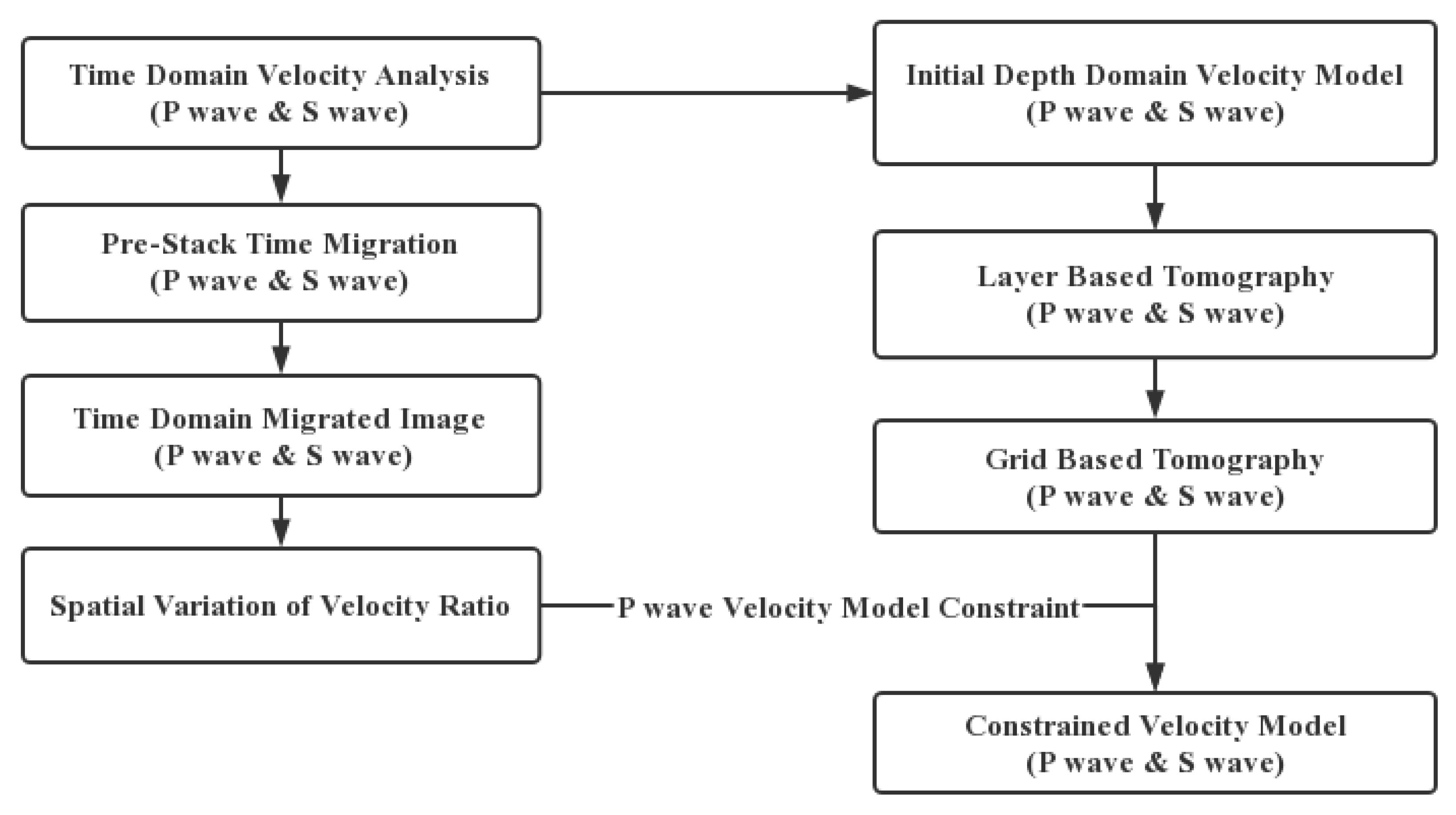
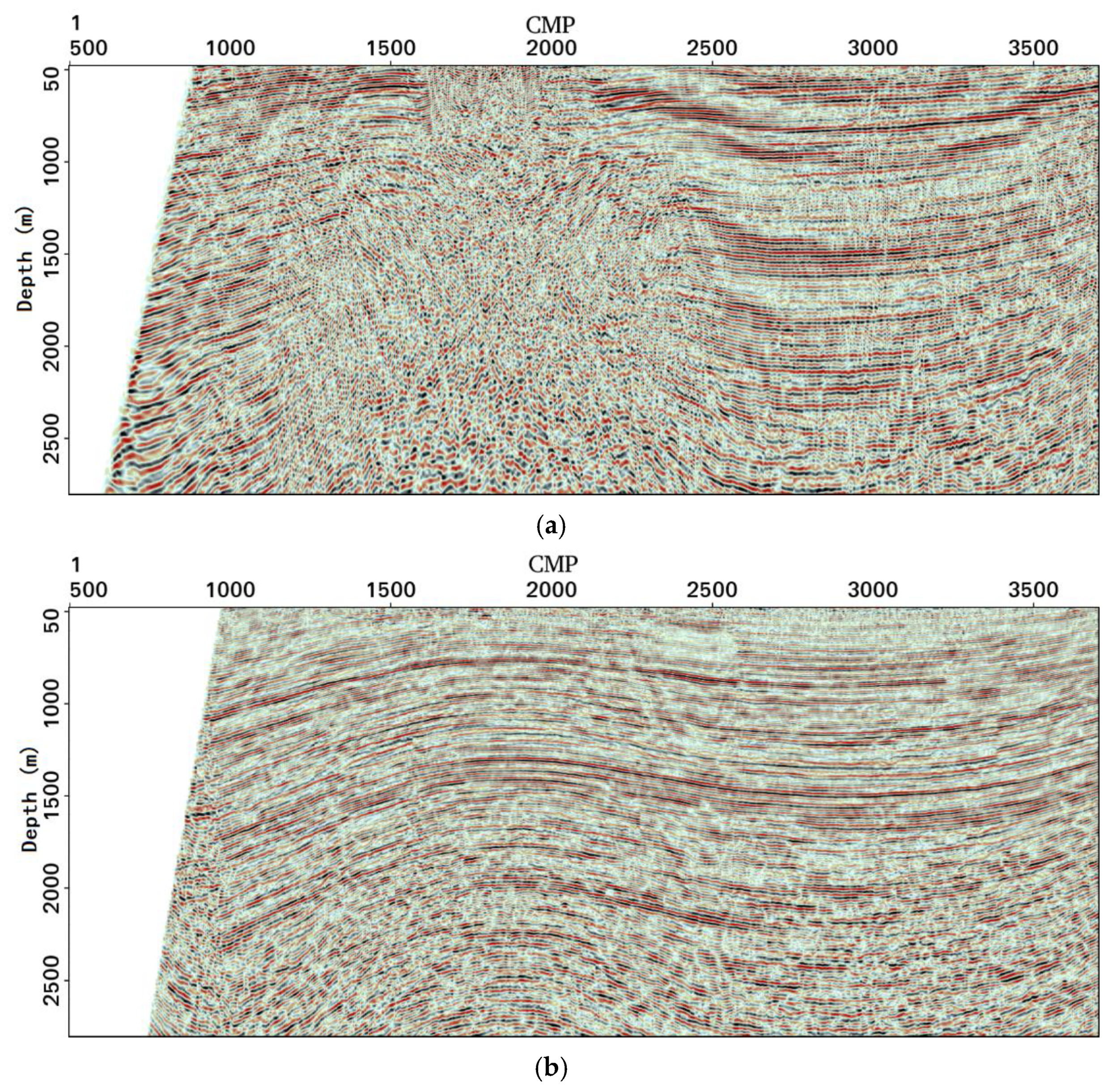
Publisher’s Note: MDPI stays neutral with regard to jurisdictional claims in published maps and institutional affiliations. |
© 2022 by the authors. Licensee MDPI, Basel, Switzerland. This article is an open access article distributed under the terms and conditions of the Creative Commons Attribution (CC BY) license (https://creativecommons.org/licenses/by/4.0/).
Share and Cite
Zhou, C.; Yin, W.; Yang, J.; Nie, H.; Li, X. Reverse Time Migration Imaging Using SH Shear Wave Data. Appl. Sci. 2022, 12, 9944. https://doi.org/10.3390/app12199944
Zhou C, Yin W, Yang J, Nie H, Li X. Reverse Time Migration Imaging Using SH Shear Wave Data. Applied Sciences. 2022; 12(19):9944. https://doi.org/10.3390/app12199944
Chicago/Turabian StyleZhou, Chengyao, Wenjie Yin, Jun Yang, Hongmei Nie, and Xiangyang Li. 2022. "Reverse Time Migration Imaging Using SH Shear Wave Data" Applied Sciences 12, no. 19: 9944. https://doi.org/10.3390/app12199944
APA StyleZhou, C., Yin, W., Yang, J., Nie, H., & Li, X. (2022). Reverse Time Migration Imaging Using SH Shear Wave Data. Applied Sciences, 12(19), 9944. https://doi.org/10.3390/app12199944





